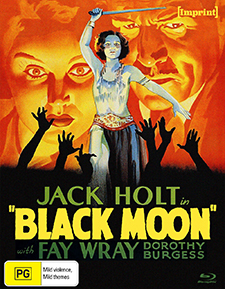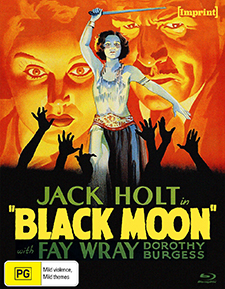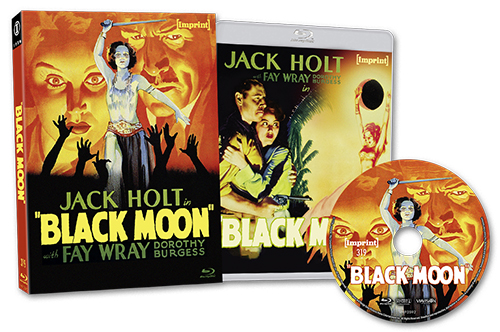Black Moon (1934) (Blu-ray Review)

Director
Roy William NeillRelease Date(s)
1934 (June 5, 2024)Studio(s)
Columbia Pictures (Imprint Films/Via Vision Entertainment)- Film/Program Grade: B-
- Video Grade: B+
- Audio Grade: B
- Extras Grade: F
Review
[Editor’s Note: This is a Region-Free Australian Blu-ray import.]
Pre-Code films have always been fascinating as they’re often much more layered than what came after the 1934 introduction of the Motion Picture Production Code, aka the Hays Code. Horror films in particular seemed to have more bite to them and tackled subjects in a more subversive way, rarely appearing outright obscene (only to those who deemed the complexities of human beings as obscenities). On the other hand, once the Hays Code was enforced, filmmakers were forced to get more creative with subtleties, creating subtexts that often went over the heads of audiences but were picked up on by critics. But before all of this took place—right on the cusp, as a matter of fact—films like Black Moon were released. Today, it’s a somewhat forgotten film as it’s mostly been unavailable to be seen (legally), but it’s also seen as quite contentious due to its portrayal of African natives.
Juanita (Dorothy Burgess) lives a loving and pampered life with her beloved husband Stephen (Jack Holt) and their young daughter Nancy (Cora Sue Collins), though Stephen grows more and more concerned about her sanity as she’s the survivor of an island voodoo ritual in which both of her parents were killed. She often feels compelled to return to the island, and against the will of her uncle, Dr. Perez (Arnold Korff), she goes back, bringing her daughter and their nanny Anna (Eleanor Wesselhoeft) with her. Meanwhile, Stephen’s secretary, Gail (Fay Wray), also comes to the island, informing him back on the mainland that things aren’t well and to come at once. After arriving, they learn that Juanita has been sneaking off at night with the natives who now treat her as a voodoo goddess, carrying out sacrifices under her orders. Gail, who has hidden romantic feelings for Stephen and cares much for Nancy, insists that they leave before any of them come to harm.
Though the reaction to the portrayal of the natives as “bloodthirsty savages” is certainly warranted, a story about a white woman leading black people to commit murder at her beck and call seems far more offensive than just the portrayal, but six of one and a half of dozen of the other. Black Moon is still an effective film regardless. It not only has genuine suspense and stakes to offer, but plenty of character development as well, without actually saying anything out loud. Both Gail and Juanita are obviously full of inner turmoil at every given turn, almost switching mother roles without realizing it, especially in the eyes of Stephen, who learns to appreciate Gail without the slightest thought of cheating on his wife. It’s refreshing, especially since it feels like the dreaded love triangle trope is about to take place at the outset, but it never really does since nobody acts on it. In other words, this is a much more interesting film than it would have been a month later under the strict censorship of the Motion Picture code.
There’s nothing particularly radical or overtly special about Black Moon, per se, outside of the subtleties in the performances (though one never tires of looking at Fay Wray), but when you’ve seen a number of these types of films, certain ones have a little more going for them. 1932’s Island of Lost Souls, 1932’s White Zombie, and 1943’s I Walked with a Zombie will always be held up as favorites with this type of story, but there others that don’t get nearly the same amount of attention, and Black Moon is one of them. It’s also rare that a film ends well with little to no dialogue, yet we understand exactly what the characters are feeling and have a good idea of where they’re headed next.
Black Moon was shot by cinematographer Joseph August on 35 mm black-and-white film, finished photochemically, and presented in the aspect ratio of 1.33:1. Imprint Films debuts this 68-minute film on Blu-ray for the first time worldwide containing two versions: the original black-and-white presentation, and a color-tinted version, each given its own respective layer on a double-layered BD-50 disc. No information is given about the master provided by Sony Pictures, but it appears to have been a recent transfer as it’s sharp with a crispness to it. The black-and-white presentation carries a somewhat tame encode that hovers around 30Mbps, rising slightly above or below here and there. Grain is heavy, but maintained as well as can be, especially since the film features a number of optical transitions, process shots, and instances of stock footage. Mild speckling and scratches pop up throughout and the stock footage itself is a bit dodgy, but nothing is overly intrusive. Grayscale is impressive at times with very good contrast and deep shadows. The tinted version (which, in this reviewer’s opinion, adds little to the film) has a slightly lower encode and appears to be taken from the same elements, since the same damage is evident in both presentations. It makes up more than half of the film’s running time, fading in for the first time around 24:16 (exactly where a new chapter occurs, funny enough). Overall, both presentations are highly organic and quite pleasant to look at.
Audio is included in English 2.0 mono DTS-HD Master Audio with optional subtitles in English SDH. It’s a fine soundtrack that carries an abundant amount of hiss that sometimes borders on distortion, though it’s obviously been attenuated. Dialogue exchanges are clear enough, and the score has surprising clarity and push to it. Sound effects are stock in nature, though the natives’ drums have some nice punch to them. Aside from a thump at 60:18, other signs of wear and tear are absent altogether.
Black Moon on Region-Free Blu-ray from Imprint Films sits in a clear Amaray case with an insert that features artwork from a US lobby card on the front and a still from the film on the reverse. Everything is housed in a slipcase featuring the original US theatrical poster artwork. Imprint’s press release indicated that the film’s theatrical trailer would be included, but it hasn’t, making this a bare bones disc.
Sony released Black Moon as a DVD-R on demand release in 2019, but thankfully, Imprint has seen to a much more desirable presentation in high definition. It may not have any bells and whistles when it comes to extras, but having both versions on Blu-ray for the first time in good quality should more than suffice for now. It’s also a vastly under-seen film that requires further appraisal.
- Tim Salmons
(You can follow Tim on social media at these links: Twitter, Facebook, and Letterboxd. And be sure to subscribe to his YouTube channel here.)


